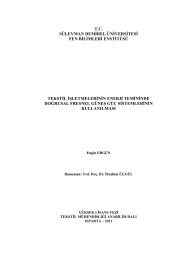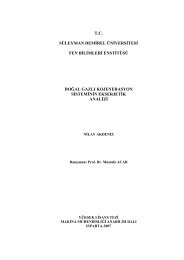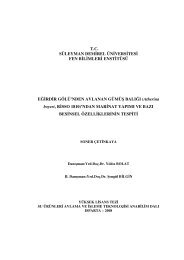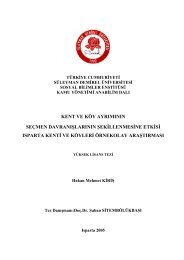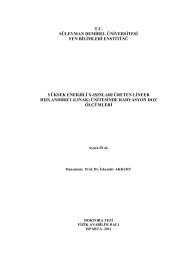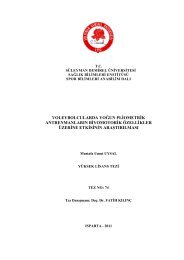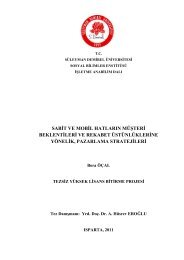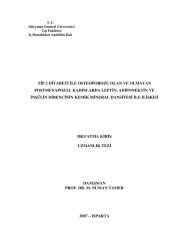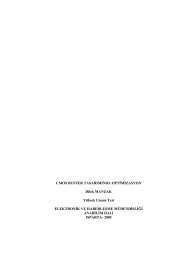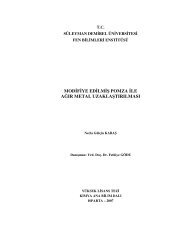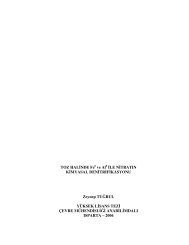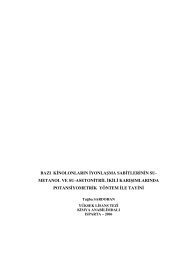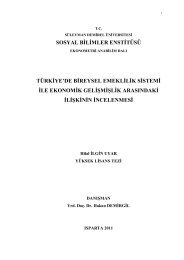tc süleyman demirel üniversitesi fen bilimleri enstitüsü kobalt
tc süleyman demirel üniversitesi fen bilimleri enstitüsü kobalt
tc süleyman demirel üniversitesi fen bilimleri enstitüsü kobalt
You also want an ePaper? Increase the reach of your titles
YUMPU automatically turns print PDFs into web optimized ePapers that Google loves.
ABSTRACT<br />
M.Sc. Thesis<br />
ACIDIC AND ALKALINE LEACHING APPLICATION TO SPENT<br />
HYDRODESULFURIZATION (HDS) CATALYSTS INCLUDING COBALT<br />
AND MOLYBDENUM<br />
M. Demet OKUDAN<br />
Süleyman Demirel Üniversitesi<br />
Graduate School of Applied and Naturel Sciences<br />
Department of Mining Engineering<br />
Thesis Committee: Prof. Dr. Abbase Güleren ALSANCAK<br />
Assoc. Prof. Dr. Ata Utku AKÇİL (Supervisor)<br />
Assoc. Prof. Dr. Mehmet KİTİŞ<br />
Increasing environmental concerns and the new obligations regarding the disposal of<br />
hazardous residues is forcing companies that are in related sectors to take new<br />
precautions for their own hazardous wastes. Recycling of some industrial waste<br />
containing base metals (such as V, Ni, Co, Mo e<strong>tc</strong>.) is estimated as an economical<br />
opportunity in the exploitation of these wastes.<br />
In this thesis research for extraction of Co and Mo from HDS spent catalysts: a<br />
hydrometallurgical process is developed as a result between two different leaching<br />
methods (H2SO4, NaOH) with calculating the effects of these methods on Co and Mo<br />
extraction. The effects of concentration of reactors (H2SO4 or NaOH), roasting<br />
temperature, roasting time, leaching temperature, pulp concentration to the Co and<br />
Mo recovery are determined. As H2O2 is considered as an alternate to the roasting<br />
process and to determine the effect of roasting, the roasting temperature and H2O2<br />
concentration are studied and to determine the effects of all these factors to the Co<br />
and Mo recovery, Yates notation and Analysis of Variance (ANOVA) methods are<br />
used.<br />
Chemical analysis showed that catalyst was included 12,3% Mo, 2,4% Co and 31%<br />
Al after drying. After roasting step the elemental composition became: 14,2% Mo,<br />
3,5% Co and 29,6% Al. As a result of leaching with H2SO4 max. %76 Co, %81 Mo<br />
and % 79 Al extraction of yield was achieved, also after leaching with NaOH, max.<br />
%90 Mo extraction yield was achieved from HDS spent catalysts. At these<br />
conditions Co was not dissolved. The results show that in acidic conditions higher<br />
metal extraction was achieved, but alkaline leaching has an advantage over acidic<br />
one because of the selective metal dissolution.<br />
Key Words: Acidic leach, cobalt, environment, HDS catalysts, hydrometallurgy,<br />
molybdenum, recovery<br />
2009, 88 pages<br />
iv



